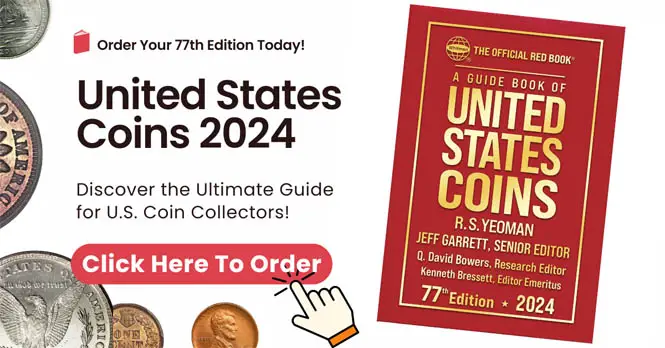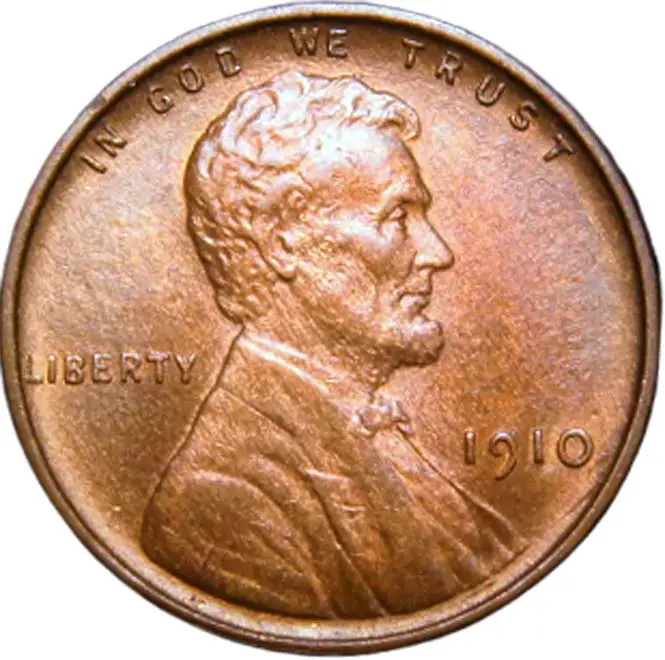- Home
- Lincoln Cents
- 1914
1914 Lincoln Wheat Penny Value: How Much Is This Cent Worth?
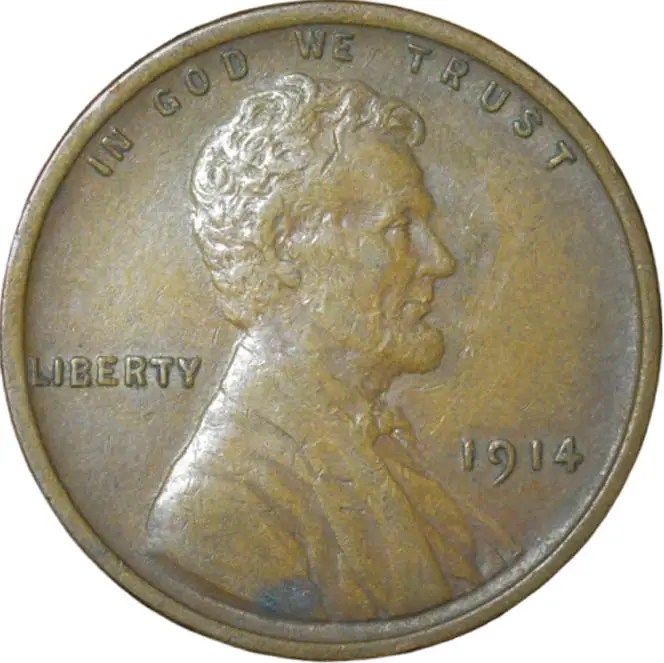
1914 Lincoln Wheat pennies are valued depending on their color, grade and where they were minted.
This can vary quite a bit and you usually find that red colored cents are the most valuable, especially the 1914-D pennies from Denver because they are quite rare and very collectible.
On average the 1914 Lincoln Wheat penny, minted in Philadelphia, is worth $1.25 in grade G4 condition. The 1914-D variety, minted in Denver, is worth $170 in grade G4 condition and the 1914-S variety, minted in San Francisco, is worth $18 in grade G4 condition.
Let's take a look below at how each variety of the 1914 penny is valued in the following pricing chart.
You'll likely find that the clear winner in terms of value and collectability for that year's wheattie is the Denver minted version due to its rarity.
| Date | VF-20 | EF-40 | MS-60 |
|---|---|---|---|
| 1914 | $6 | $20 | $65 |
| 1914 (D) | $300 | $700 | $2500 |
| 1914 (S) | $40 | $95 | $325 |
(S) minted in San Francisco. (D) minted in Denver.
Valuation Source: The Official Red Book 77th Edition 2024
1914 Wheat Penny Value
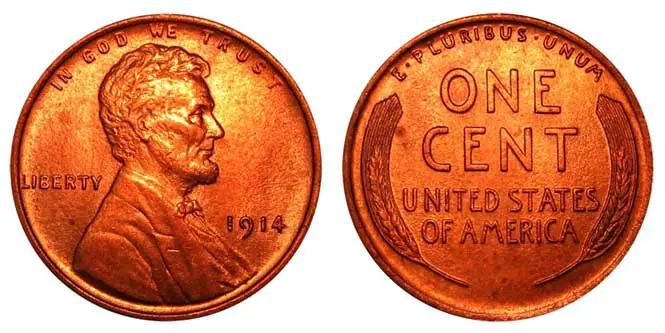
*Image Courtesy of USA Coinbook
- Designer: Victor David Brenner
- Metal Composition: 95% Copper - 5% Tin & Zinc
- Diameter: 19mm
- Weight: 3.11 grams
According to PCGS, the standard 1914 Wheat penny minted in Philadelphia is valued at between $1.25 and $50,000.
You can identify these cents quite easily as they have no mint mark below the date.
There were 75,238,432 produced in Philly that year making them easy for collectors to find. You can pick up a MS60 uncirculated cent for around $65.
A good condition coin with a grading of G4 would be worth $1.25, whereas a MS67+RD would be valued at around $50,000.
A total of 1,365 proof versions were also created with their value being around $425 for a PR60BN and $110,000 for a PR68RD.
1914-D Wheat Penny Value
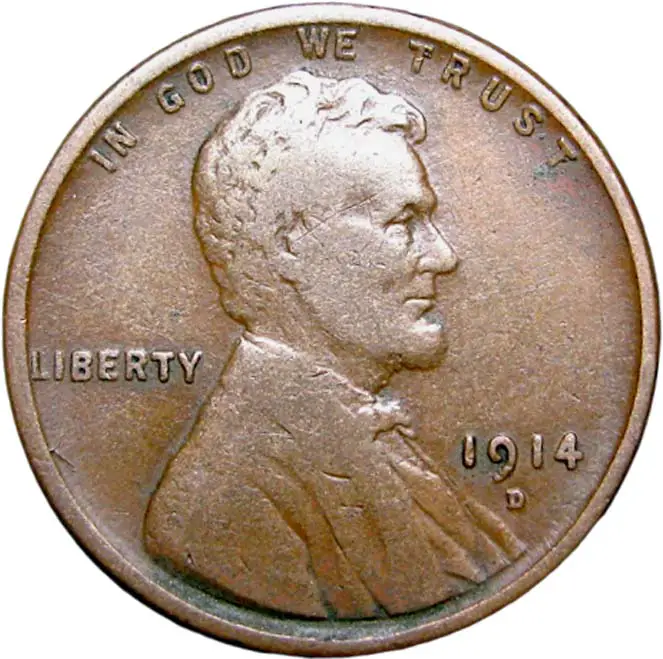
The Denver Mint produced only 1,193,000 pennies in 1914, a relatively low number compared to other years.
For comparison, the Philadelphia Mint struck over 75 million pennies that same year. This limited mintage immediately made the 1914 D penny a rarer find for collectors.
Rarity in coin collecting often increases value, especially as collectors seek higher-grade coins in good condition.
The 1914 D penny is rare across all conditions but is particularly scarce in higher grades, where the details of Lincoln's profile and the wheat stalks remain well-preserved.
The 1914 D Lincoln Wheat Penny’s value varies greatly by grade. Here’s an approximate value range:
- Good (G4): Around $170.
- Very Fine (VF20): Between $300 and $400.
- Extremely Fine (EF40): Approximately $700 to $1000.
- Mint State (MS60-MS65): These coins can fetch $2500 or more, with high-grade examples exceeding $20,000 in some cases.
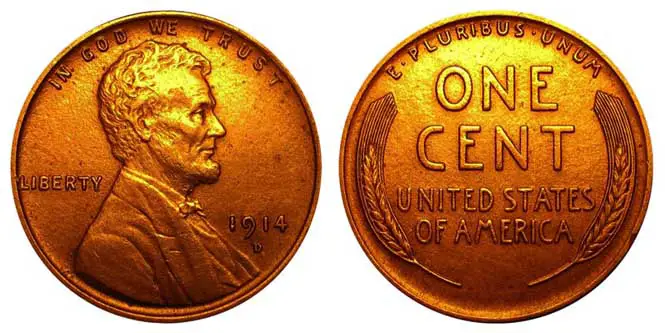
*Image Courtesy of USA Coinbook
Authenticating the 1914 D Lincoln Wheat Penny
Authentication is key to ensuring the 1914 D penny’s value, as counterfeits exist. One common counterfeit method involves adding a “D” mint mark to a 1914 Philadelphia penny.
Under magnification, altered coins often show signs of tampering, such as uneven surfaces or color differences around the mint mark. Professional authentication services have the expertise and equipment needed to verify authenticity.
1914-S Wheat Penny Value
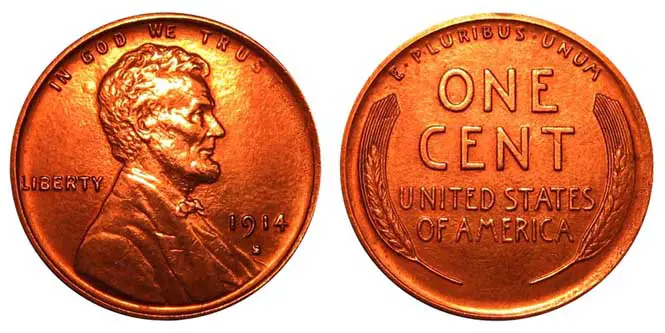
*Image Courtesy of USA Coinbook
The 1914-S Lincoln Wheat Penny is one of the most sought-after coins in the Lincoln cent series. Due to its lower mintage, it's more scarce and valuable compared to other dates in the series.
The 1914-S penny was minted in San Francisco, with a total mintage of 4,137,000 coins. Compared to Philadelphia’s mintages for Lincoln pennies during the same period, this number is relatively low, contributing to its rarity.
Here’s an estimated breakdown of values based on grade:
- Good (G-4): Coins in this grade are heavily worn but have clear, readable dates and mintmarks. Approximate value: $18.
- Very Fine (VF-20): Shows moderate wear with all design elements still visible. Approximate value: $40.
- Extremely Fine (EF-40): Light wear on the high points, with strong details remaining. Approximate value: $95.
- About Uncirculated (AU-50): Slight traces of wear on only the highest points. Approximate value: $150.
- Mint State (MS-60 to MS-65): Uncirculated with full design details and varying degrees of mint luster. Values can range from $325 to over $5,000 for top grades.
These values fluctuate with the coin market, so prices may vary over time. In general, the better the coin’s condition, the higher the price collectors are willing to pay.
Given the 1914-S penny’s high value, counterfeit versions are common. Some fake coins are made by altering a 1944-S penny by modifying the date, while others involve adding an “S” mintmark to a 1914 Philadelphia penny.
To protect your collection and investment:
- Look for Date Alterations: Check the style of the numerals, especially the “1” and “4” in the date, which should match genuine 1914-S pennies.
- Examine the Mintmark: The “S” should have specific shape characteristics and placement. It’s essential to compare it to authenticated examples or use a loupe for detailed inspection.
- Consider Third-Party Grading: Submitting your coin to a grading service like PCGS (Professional Coin Grading Service) or NGC (Numismatic Guaranty Corporation) ensures professional authentication.
Taking these steps can help identify counterfeit coins and ensure the integrity of your collection.
Return to Lost Treasure HQ to learn more about coin and note collecting.
Lincoln Wheat Cents 1909 - 1958
1909, 1910, 1911, 1912, 1913, 1914, 1915, 1916, 1917, 1918, 1919, 1920, 1921, 1922, 1923, 1924, 1925, 1926, 1927, 1928, 1929, 1930, 1931, 1932, 1933, 1934, 1935, 1936, 1937, 1938, 1939, 1940, 1941, 1942, 1943, 1944, 1945, 1946, 1947, 1948, 1949, 1950, 1951, 1952, 1953, 1954, 1955, 1956, 1957, 1958.
*Image Credit: USA Coinbook
